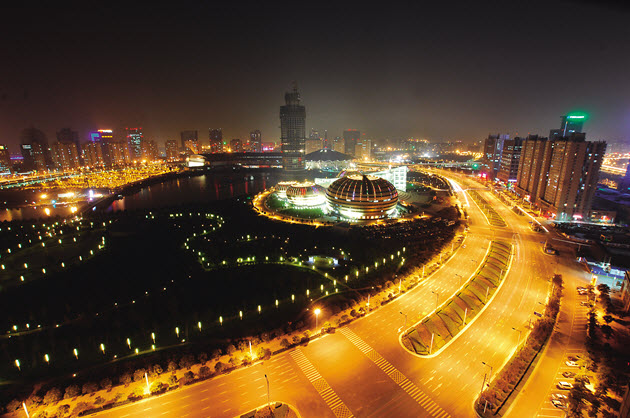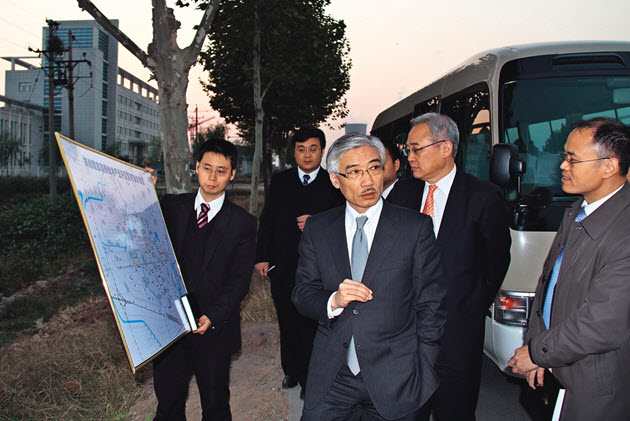China's Industrial Relocation
There's Gold in the Hinterland

Source:Kuo-Tai Liu
Once regarded as a desolate wasteland, western China is now thriving, with companies from around the world eager to get a piece of the action. What are they doing to capitalize on this new "Journey to the West"?
Views
There's Gold in the Hinterland
By Sherry Lee, Benjamin ChiangFrom CommonWealth Magazine (vol. 459 )
China's coastal cities once dominated the attention of entrepreneurs, political leaders and foreign experts, but western China seems to be at the top of their itineraries today. Taiwan's five major electronics vendors (Hon Hai/Foxconn, AsusTek, Quanta, Compal, and Acer) are no exception. To better compete for orders, they are following in the footsteps of Hewlett-Packard and Dell by pulling out of eastern China and moving 2,000 kilometers inland to Chongqing and Chengdu in Sichuan Province and Zhengzhou in Henan Province, where they intend to forge new production bases.
The traditional path taken by Taiwanese companies to establish a presence in China is also gradually changing. At the airports of Chongqing, Chengdu, Zhengzhou, Guiyang, Hohhot in Inner Mongolia and Urumqi in Xinjiang, it is no longer uncommon to run into businessmen from Taiwan, as well as from Hong Kong, Macau, Europe, North America and the Middle East.
Among Taiwanese companies, major manufacturers are not the only ones looking west. Several trading companies and venture capitalists have also joined the wave in search of opportunities.
Not long ago for example, Him Han, manager of Taiwan's biggest organic foods distributor Leezen, traveled from the capital of Qinghai Province, Xining, to the 3,000-meter high Qaidam Basin 400 kilometers to the west in search of organic wolfberries, or gouqi in Chinese.
He has made over 20 trips into China in recent years to source the 30 tons of organic wolfberries and 50 tons of organic Chinese red dates Taiwan requires per year, but because China's coastal areas are too humid and highly vulnerable to plant diseases, Han has turned to the country's inland highlands, which have become his most important production and supply source.
China's New Blue Ocean
Investors are flocking to western China hoping to find a new "blue ocean." York Chen, the president and managing partner of iD TechVentures, Inc., a subsidiary of the iD Soft Capital Group founded by former Acer chairman Stan Shih, has been posted in China since 2000. In his first five years there, he looked for investment opportunities primarily in Beijing, Shanghai, Guangzhou and Shenzhen. But because the competition in China's coastal areas grew too intense, Chen began looking west three years ago. At the end of September this year, he chose Chongqing as the site for a major meeting of venture capitalists.

"In the past, there was nobody who would fly for three hours to inland China to check out the possibilities," Chen said.
Companies are once again active in inland China, the place they read about in their history textbooks that has now taken on a completely new look.
Supporting Cast Gets Leading Roles
In 1999 when Jiang Zemin was president, the government launched a strategy to develop western China and stimulate the rapid rise of the central part of the country, hoping to balance economic development that even then was already clearly tilted toward the coastal part of the country. The key development areas in inland China are now Lanzhou, Xining and Yinchuan in the northwest; Hohhot, Baotou and Ordos in Inner Mongolia; Chengdu and Chongqing in the west; Changsha, Zhuzhou and Xiangtan in central China; and Nanning and Liuzhou in the southwest.
China's state capitalism policies have heavily buttressed development of its interior. For every 10 renminbi spent in the west's 12 provinces, regions and cities, four come directly from the central government.
Although China has invested a considerable sum in the region over the past 10 years, foreign enterprises have moved in at a relatively slow pace. According to government figures, of all the foreign companies registered in China, only 6 percent have a presence in western China, a mere fraction of their operations in China's coastal areas.
Part of the problem is that many foreign and Taiwanese enterprises have had trouble deciding if they want to establish a presence in this remote region that defies market logic, can be difficult to fly to and lacks a modern business environment.
But that outlook cannot alter China's determination to develop its hinterland, for a number of reasons:
1. Widening wealth gap, deteriorating environment
China has pursued its policy of "reform and openness" for 30 years, but imbalances in regional development have only grown worse. Sixty percent of China's poor and two-thirds of its poor counties are in the west, as is 80 percent of the country's soil erosion and new desertification.
2. Excessive reliance on exports to generate economic growth
The global financial crisis and its aftermath exposed China's complete reliance on exports as its only engine of economic growth. Stimulating domestic demand is an absolute necessity to offset weakening export strength.
3. Two "relocations" overdue
The inland relocation of both industries and workers has become a top priority of coastal area governments. Under pressure to meet environmental protection and low carbon emission manufacturing goals and to deal with population and security issues, authorities are expediting the relocation of certain sectors to central and western China.
4. Threats to national territory and strategic security
Roughly 85 percent of China's territorial border and 75 percent of its minorities are in the west. The riots in Xinjiang in 2009 and recent territorial disputes in the East China and South China seas have prompted China to ponder its mid- and long-term national territory and security strategy. In the future, China will invest heavily along two different corridors: in the west to extend the Asia-Europe land bridge and in the southwestern provinces of Guizhou and Yunnan to further project and consolidate its influence in Southeast Asia.
Incentives to Move Inland
Over the past 10 years, China has used its financial muscle to strengthen the central and western parts of the country and shifted expired incentives offered in the east to the west. Aside from financial incentives and tax breaks, China has expended considerable effort in the past two years to encourage the redeployment of talent inland.

The "Outline of Plans to Deepen Reforms of the Cadre and Personnel System, 2010-2020" issued by the Communist Party's Central Committee last year even more clearly articulates the need for cadres to interact with impoverished regions. The Organization Department of the party's Central Committee, for example, transferred 60 high-ranking cadres, at the national deputy department level, to counties and cities in central and western provinces to gain experience as deputy mayors or deputy party secretaries.
Before becoming the secretary of the Communist Party's Chongqing Municipal Committee – the city's top post – in 2007, Bo Xilai had previously served as mayor of Dalian, the governor of Liaoning Province and the minister of commerce, a profile that helped raise Chongqing's national and global visibility.
Opening Remote Areas to the World
The massive injection of policy initiatives, funding and talent has turned central and western China from supporting actors into stars.

Nanning, the capital of Guangxi Province, has become an important hub for China's interaction with the countries of ASEAN (Association of Southeast Asian Nations). Each ASEAN country has established a consulate and commercial office in the city, and some facilities symbolize the importance countries attach to their presences there. Cambodia's building in Nanning is even taller than its own White House, and Vietnam's consulate is architecturally imposing.
Over the past year, foreign banks have also set up branches in western cities. Citibank set up a branch in Guiyang in Guizhou Province and Hang Seng Bank established a branch in Kunming in Yunnan Province.
Despite the recent push west, some Asian countries and enterprises actually set up presences there long ago. International Enterprise Singapore, an agency under Singapore's Ministry of Trade and Industry specializing in helping companies resolve problems and disputes, set up an office in Chengdu 10 years ago and another one in Xi'an five years ago. It also recently established a representative office in Chongqing. Singapore will also open a consulate in Wuhan in November, to add to its embassy in Beijing and consulates in Shanghai, Guangzhou and Chengdu.
Because the competitive threshold in western China is relatively low, it has also satisfied the ambitions of many entrepreneurs looking to China to set up a second business or for bigshot businessmen hoping to amass land.
Staking Claim to Land
Kent Hsu, the chairman of Taiwan-based notebook computer maker Clevo Corp., said he spends three-quarters of his time prospecting more than 200 lower-tier cities in China and recently has been assessing the western China market. This year, the company opened a Buynow IT Mall in Chongqing and a Chicony department store in Chengdu. The latter, which opened at the end of October, is considered to be the biggest department store in southwest China.

This wave of development resembles the western expansion of the United States in the 19th century, with both companies and individuals racing to stake claims to territory.
Although the central government has repeatedly prohibited companies and local governments from colluding to appropriate land, localities have continued to promote preferential land policies to attract private companies and increase tax revenues.
After tasting the spoils of these land policies, many Taiwanese companies have started to extend their ambition to the west to stake claims to more real estate.
They generally band together to ambitiously negotiate the lowest possible land purchase prices with local governments and then resell it to contractors in their supply chains. When claimed land is resold, they almost inevitably make a healthy profit on the land's appreciation in value.
In one case, an OEM electronics manufacturer with a production facility in western China needed only 75 acres of land when it was planning the complex but instead laid claim to about 150 acres.
It bought the 150 acres at a price of 333,000 renminbi per acre, and as soon as news emerged that the company was setting up a factory there, the price per acre of land in neighboring areas more than doubled overnight. Two months later, the electronics contractor sold half of the 150-acre plot to a supplier at a price of 533,000 renminbi per acre.
"They made 15 million renminbi on the transaction. This is an easier way to make money than opening a factory," observes one China-based Taiwanese businessman.
This land-grabbing phenomenon has extended to the agricultural sector. Watson Lien, the vice chairman of a Taiwanese business group in Zhengzhou, was able to claim a 1,500-acre piece of land – about 38 times the size of the Daan Forest Park in Taipei – on the banks of the Yellow River, and he used it to create Zhengzhou's biggest ecological farm.
Dramatic Growth in Spending Power
Another factor driving the move west is the surfacing of long pent-up demand among consumers in central and western China.

Four years ago, Jeffrey Shen was sent by Ford Motor Co. to Chongqing to take over as president of Changan Ford Mazda Automobile Corporation Ltd., a joint venture between Ford and China-based Changan Auto Group Corporation. Shen, who stepped down from the post in early November, said that sending somebody like him with experience in both Taiwan and the United States to a virgin territory that was taking off guaranteed fast business growth.
"Of course you have to compete in the top-tier cities. You need to have a flagship and to serve the top consumers, but it is also intensely competitive. Everybody there is trying to kill everybody else. It's like a killing field. But now there is a virgin territory, one that you definitely want to enter to improve market share," Shen said.
Over the past four years, Changan Ford has grown at a rate of 54 percent per year, higher than the market average. But the 40- to 80-percent growth seen in second- and third-tier cities far surpasses the 30-percent growth experienced in first-tier cities. The company's most popular models in the western and central parts of China have been mid-priced Mazdas, costing between 70,000 and 100,000 renminbi.
The region is a virgin territory where taking the right risks can generate a fortune. "Consumers in the west are not like people in Beijing and Shanghai who favor trendy items. Once they take to a certain product, you'll have a tough time getting them to change their brand loyalty," stresses Aden Tsai, the president of Dennis Department Store Co. He says that in central and western China, the most important priority for a company is to enter the market early and become the most recognizable brand among local consumers.
Feng Lun, the chairman of Beijing Vantone Real Estate Co., believes that companies in China must deal with two different tracks of development – looking to coastal areas and Beijing for talent and technological advantages, and looking inland for cost advantages and proximity to markets. Different regions will play different roles in the future, he says.
Jack J.T. Huang, partner-in-charge of Jones Day's Taipei office, sums up the optimism many have for the region's coming decade.
"From the occasional oasis sprouting up in the desert, it has become a boundless field of green," he says.
Translated from the Chinese by Luke Sabatier






